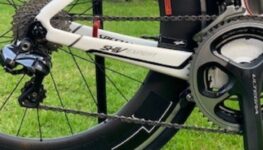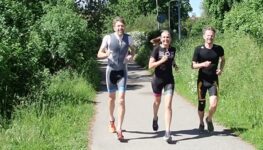Pacing with Perceived Effort
Pacing
Although the title of this podcast is somewhat vague and misleading – “Pacing”, in our point of view – the content makes perfect sense.
To clarify, Kristian talks extensively of perceived effort pacing, not pacing by speed, power, or other metrics. As we have discussed with you all in the past, pacing by speed, etc will naturally vary depending on the duration of the session, the terrain, gradients and any external stress; “perceived effort” pacing will always remain the same.
For example, running for 90minutes at a perceived effort of EASY throughout means your perceived effort is fixed whilst your speed will increase or decrease depending on external factors such as wind, gradients and the fact that you will suffer cumulative fatigue.
So moving on…
Pacing, think of it as: “setting or regulating input of exertion when training or racing”
Hone your skill
Pacing is a trainable ability / skill; EVERY training session provides the opportunity to learn how to manage your pacing and feel the corresponding perceived effort. There are various pacing methods, you should be familiar with them – whether you are directly aware or not. Here are three of the main pacing methods you encounter regularly:
- Even pacing – holding a prescribed effort pace from start to finish (60min EASY).
- Negative splits – start easier than you finish; start VERY EASY, finish MEDIUM (Out and Back’s). This is also the race day pacing method.
- Kick-ups – doing structured durations of harder efforts as part of a warmup, main set or cool down.
On race day, especially “A” race day, we recommend you negative split your effort in each section of the race – start EASY, settle into MEDIUM. The key being to “settle” into MEDIUM as you will be hyped from the excitement and EASY will be slightly harder than EASY – more like MEDIUM! So after a short period, you will settle into a true MEDIUM – as fatigue sets.
Do this and you will survive the experience in a positive way! As Kristian says: the winners of endurance races are those who slow down the least. Negative splitting ensure you don’t slow down!
Endurance training is not SEXY – but is enjoyable!
As you are ALL endurance athletes, get used to the ‘non-sexy’ training: the EASY sessions! There are no shortcuts – no hacks, no gadgets, no (legal) supplements. Fitness can be developed with a little aerobic work and a lot of hard work (high intensity training (HIT) type sessions or just middle ground training) but is not going to lead to a robust or effective system. Compare a HIT trained person to someone who has spent hours, days, weeks, months and YEARS doing the EASY work and the EASY athlete will win and will be healthier!
Don’t just think of your aerobic training as being specific to the heart, lungs, muscles, tendons, etc, it is time to train your intuition too – your perceived effort! It all requires patience, and to ignore noise (noise being anything external that influences your training mindset – data, media, friends, etc).
You SHOULD be in control of yourself, always prioritising your feelings over any technological readings you may have access to. If you do this, your intuition will be honed and you will trust it more and more – being confident enough to act on it, instead of questioning yourself.
Gadgets, Technology and “Science”
As we have mentioned in the past, TRUST the processes of training and don’t ‘outsource’ the control of training, or racing, to gadgets. Use them as the tool that they are, but never let them dictate what you do. Get into the habit of looking at data AFTER sessions to compare, and hopefully confirm, how the session went in relation to how it felt. If the data is elevated, erratic or low, it could:
- be an issue with the gadget (very common at the moment!), or
- give you an indication that something may not be right and that you should monitor yourself over the coming days and need more fuel, sleep, or your body is fighting off a virus, etc.
The sports technology market is heavily diluted, technology has become cheap and easy to make, once it was a specialist market with only universities and pro teams having access to it. But now, with all the different brands, there are dozens of “scientific” theories and training levels to be followed.
As endurance athletes, there are two main issues linked to this:
- the levels don’t match our chosen levels (those used/recommended by Prof. Stephen Seiler, Phil Maffetone and Brett Sutton) so you will often be misled and working harder than we want you to if you follow levels set by technology. Check your athlete pack and the bike HR tab for the levels we have.
- there are too many levels, – the high levels are narrower and effectively noise. These high levels (for example, 5, 6, 7, etc) are not specific to any endurance athletes; they are too hard. Even when we prescribe higher intensity sessions you shouldn’t be working higher than 15beats below maximum HR.
These higher levels are more suited to athletes doing short events that are at or over threshold, and even then, they (or their coaches) will have their specific levels and the athletes must have “earned” the right to train that hard!
Remember that a runner finishing a marathon in just over 2hrs is still running at an aerobic pace, and can do so based on YEARS of aerobic training
Too many people get stuck in the middle training levels, 3-4, which distorts the athlete’s perception that it is easy, and is why races are often poor as the pace is too high at the start (the “one speed syndrome” or ADS (aerobic deficiency syndrome – as Kristian and Phil Maffetone call it)
Developing your ability to use intuition, perceived effort, allows you to control pace and will account for external factors that gadgets are not able to; factors such as sleep, work stress, nutrition.
Intuitive intensity “levels”
VERY EASY: nose breathing, can perform at this level all day long, no feeling of stress, feel fresh and allows you to tune-in to yourself; your breathing, what your muscles feel, etc.
EASY (Kristian’s moderate): still aerobic and feels comfortable, with a feeling of strength but with heavier breathing so there will be some pauses when talking – for the most part, you can still breathe through just your nose, especially if you persevere with nose breathing training.
MEDIUM (Kristian’s moderate/hard): still aerobic but just below or at threshold, this is an intensity that is straining your body (breathing, muscles) and feels uncomfortable – and should not be used very often.
HARD (Hard): this is unpleasant, above threshold and results in loud/hard breathing. This trains lactate tolerance but relies on having a good aerobic base and must only be used for short periods; recovery between repeats MUST be adequate to get the benefits of this training. Recovery doesn’t need to be long; recovery needs to be easy enough in the prescribed time to get the body recovered.
Notice how these align with the training intensities we prescribe? Recheck the “Effort Descriptions” in the Athlete Resource folder (in the Athlete Support Document folder) in Dropbox if you need to.
FTP
Functional Threshold Power… or as we term it Fucking-up The Process!!
Another topic we discuss with you, and during the last Teams talk was that FTP is a poor method for zone assessment/training as it doesn’t account for external stress and is a number in isolation, and so is poor as a guide for racing. If you do need to see numbers, always put them in context and cross check with feelings after the session as above.
How do you know that you are improving if using intuition?
As you should all be aware, your training regularly includes doing the SAME or VERY similar sessions – but regularly returning to the base sessions each training block. We highly recommend most of your training be done indoors in pools, on indoor trainers, on treadmills all year round. And when you train outdoors, we recommend that you use the same, repeatable, small routes.
All of this is because it makes training controllable, repeatable and referenceable, helping you to “learn” how you feel, read the terrains, etc.
Consequently, your intuition WILL improve, even with increased training load, you will know what is going on because you have hundreds of hours of experience to call upon.
It is important to re-emphasise that you shouldn’t expect each session to be better than the previous one, as external influences will affect how you feel, pace, etc. But you will still know how you are feeling and can train at that required intensity!
Playing in the different intensity levels
Fartlek training (speed play) is good for experiencing the different efforts (paces) and how they feel. Doing so helps you to learn what going too hard is like, and how to spot the signs early in training or racing, so you can ease back.
Just make sure you don’t get stuck in the middle levels! Contrasting efforts with adequate recovery. As with the Effort Descriptions document, refer to the (True) Fartlek Run Sessions document in Dropbox (in the Running folder).
Out and Back sessions are another good session type for pacing management and learning, especially if you use the same routes each time. These can be great confidence boosters, when you can run back in the exact same time (perfect pacing) or you run back faster than you did previously (getting fitter).
Conclusion
- Make training simple (uncluttered with gadgets and data) – we did “Data-less” December in 2019, do it again sometime soon?
- Be in the moment and be honest with yourself and how you feel EVERY session
- Train to develop your intuitive pacing consistently; along with aerobic efficiency, it takes years so be patient and you will reach your potential
Becoming a body whisperer explains how to develop pacing in more detail.
Homework
Answer the following questions – sit, think and WRITE your answers down. Keep them for yourself or send them to us…
- WHY have you bought the gadgets you have?
- Peer pressure, clever marketing, pure/honest curiosity?
- WHAT did you hope to gain?
- Marginal gains, the ability to switch off and simply chase numbers, tracking progress?
- DO you understand why they are inferior to your body and intuition?
- ARE you committed to further developing your intuition and self-reliance?



